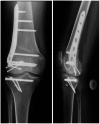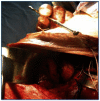Allograft replacement for absent native tissue
- PMID: 24427387
- PMCID: PMC3658384
- DOI: 10.1177/1941738112456668
Allograft replacement for absent native tissue
Abstract
Context: Structural instability due to poor soft tissue quality often requires augmentation. Allografts are important biological substitutes that are used for the symptomatic patient in the reconstruction of deficient ligaments, tendons, menisci, and osteochondral defects. Interest in the clinical application of allografts has arisen from the demand to obtain stable anatomy with restoration of function and protection against additional injury, particularly for high-demand patients who participate in sports. Traditionally, allografts were employed to reinforce weakened tissue. However, they can also be employed to substitute deficient or functionally absent tissue, particularly in the sports medicine setting.
Objective: This article presents a series of 6 cases that utilized allografts to restore functionally deficient anatomic architecture, rather than just simply augmenting the degenerated or damaged native tissue. Detailed discussions are presented of the use of allografts as a successful treatment strategy to replace functionally weakened tissue, often after failed primary repairs.
Keywords: allograft; instability; ligament; reconstruction; tendon.
Figures






References
-
- Aarimaa V, Rantanen J, Heikkila J, Helttula I, Orava S. Rupture of the pectoralis major muscle. Am J Sports Med. 2004;32(5):1256-1262 - PubMed
-
- Alcid JG, Powell SE, Tibone JE. Revision anterior capsular shoulder stabilization using hamstring tendon autograft and tibialis tendon allograft reinforcement: minimum two-year follow-up. J Shoulder Elbow Surg. 2007;16(3):268-272 - PubMed
-
- Alford JW, Cole BJ. Cartilage restoration, part 1: basic science, historical perspective, patient evaluation, and treatment options. Am J Sports Med. 2005;33(2):295-306 - PubMed
-
- Alford JW, Cole BJ. Cartilage restoration, part 2: techniques, outcomes, and future directions. Am J Sports Med. 2005;33(3):443-460 - PubMed
-
- Barker JU, Drakos MC, Maak TG, et al. Effect of graft selection on the incidence of postoperative infection in anterior cruciate ligament reconstruction. Am J Sports Med. 2010;38(2):281-286 - PubMed
LinkOut - more resources
Full Text Sources

